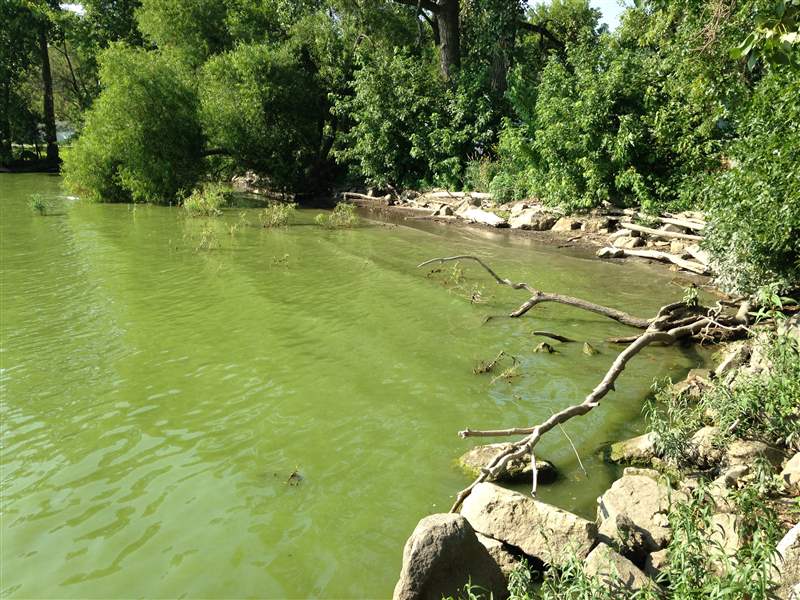
Environmental group seeks to join algae lawsuit
8/16/2018
An algal bloom seen at Grand Lake Saint Marys in 2014.
Daniel McInnis/SPECIAL TO THE BLADE
Buy This Image
A fourth entity has filed a brief in U.S. District Court seeking legal standing from Judge James G. Carr so it can help two groups in a lawsuit seeking a comprehensive remedy for western Lake Erie algal blooms.
An environmental group called Guardians of Grand Lake St. Marys said in a 14-page motion filed Thursday that it has “a critical story to tell the Court as an amicus in this case about the consequences for the State of Ohio’s refusal to forcefully implement the Clean Water Act.”

Judge James Carr
That group contends Grand Lake St. Marys — the largest inland lake completely within Ohio — is even more impacted by phosphorus pollution and resultant harmful algal blooms, or HABs, than Lake Erie.
In its motion, it calls Grand Lake St. Marys “the poster child for toxic algae blooms,” in large part because of a dense concentration of livestock and the manure that’s produced by the animals. It claims the Grand Lake St. Marys area incurs losses of $60 million to $80 million a year from the pollution.
Unlike Lake Erie, the Grand Lake St. Marys watershed has been assigned a total maximum daily load, or TMDL, strategy for restoring its ecological health.
“And while the State of Ohio has not fulfilled its duties under the Clean Water Act to fully implement the TMDL in [Grand Lake St. Marys], the small progress that can be found is fully due to the existence of the TMDL in the watershed.”
By far the most site-specific, complex, and costly of all strategies, a TMDL is used to set limits for how much pollution a river, lake, stream, or other type of ecosystem can reasonably withstand. It differs based on location, size, soil, and other factors — but the strategy often comes back to the concentration of runoff from area farms.
Guardians of Grand Lake St. Marys has joined the cities of Toledo and Oregon, plus the Lake Erie Foundation in filing requests with the court to participate in the case brought against the U.S. EPA by the Environmental Law & Policy Center and Advocates for a Clean Lake Erie. The additional parties began seeking standing Aug. 10.
The two plaintiffs filed the case last year over the U.S. EPA’s willingness to allow the state of Ohio to forgo an impairment designation for western Lake Erie, even though Michigan declared its much smaller portion of the lake as impaired in 2016. In January, the U.S. EPA notified the state agency it had second thoughts and, in March, the Kasich administration declared western Lake Erie as impaired after years of resistance on behalf of agriculture.
Now, the question before the court is whether it can order a TMDL cleanup strategy for the lake.
The two groups that brought the suit claim such a wide-ranging, cleanup strategy is required under the Clean Water Act. The U.S. Department of Justice, which is representing the U.S. EPA, disagrees. The Justice Department also states that Ohio has never actually refused to do a TMDL for Lake Erie.
The case in back in federal court Tuesday in Toledo.
According to Guardians of Grand Lake St. Marys, the 11,500 people living in Celina, Ohio, rely on Grand Lake St. Marys as their sole source of drinking water, and their drinking water plants have spent millions of dollars on extra filtration to remove algal toxins.
The group draws parallels to what has been happening in western Lake Erie, stating in its motion the U.S. EPA and the state of Ohio “should not be allowed to take a similar unlawful approach in Lake Erie.”
“The story of Grand Lake St. Marys can uniquely inform this Court about the consequences of the State of Ohio’s unlawful approach to implementing the Clean Water Act’s requirements in Lake Erie,” the motion states.
Contact Tom Henry at thenry@theblade.com, 419-724-6079, or via Twitter @ecowriterohio.